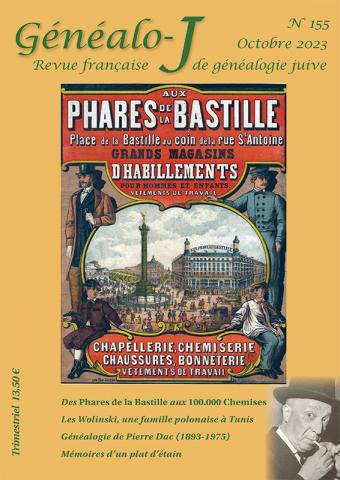
Anne-Marie Fribourg
From the “Phares de la Bastille” to the “100.000 Chemises”: the commercial epic of the Maus and Schwob families
The story of a Parisian store, a major clothing company and the defense of small shopkeepers through three figures representative of their era: Gabriel Maus, Maurice Schwob and Georges Maus. We discover social patronage and the birth of «advertising».
Denis Lévy
The Wolinskis, a Polish family in Tunis
Georges Wolinski’s paternal family was one of a handful of Polish Jews who left their homeland for a better life in Tunisia. The article tells the story of the cartoonist’s grandparents, parents, uncles and aunts, from their arrival in Tunis in the 1920s and 1930s to their departure for France or Israel after the war. They forged alliances with families from Livorno (Bembaron, Costa, Attia), Tunisia (Nataf ), Sicily (Catholics)... and almost all became French.
Pierre-André Meyer
Genealogy of Pierre Dac (1893-1975)
The beautiful exhibition devoted this year to Pierre Dac by the Museum of Art and History of Judaism (Paris) is an opportunity to revisit the genealogy of the famous humorist: an entirely Alsatian genealogy, mainly from the Lower Rhine, with in particular the Isaac family in Uttenheim and the Kahn and Braun families in Niederbronn, forming a complicated web of multiple alliances between them. From the middle of the 19th century, the Isaacs left Alsace for Lorraine, then went to Champagne, where the Kahns settled after the Treaty of Frankfurt (1871). This is how André Isaac, the future Pierre Dac, was born in Châlons-sur-Marne, a city he nicknamed “Chalom-sur-Marne”. But very quickly, his parents reached Paris, thus following the route of many Jews from Alsace.
Michel Gaspard, Florian Mahon
Memoirs of a tin plate
A tin plate, used for the Seder, the ritual meal of Pesach, tells the story of the family life it has witnessed. The dish has been handed down from generation to generation, from its birth in the 18th century to the present day. Four generations of the Lévy family lived in Scharrachbergheim, near Strasbourg, from the time of the French Revolution until 1900. Every year, they faithfully celebrated the Passover ritual around the same dish. But the next three generations, with their migration in the 20th century to Wissembourg, Strasbourg and then Paris, saw the religious practice fade away. After the marriage of the last Lévy heiress to a non-Jew in 1945, the old pewter dish became no more than a decorative object, symbolizing the break with two centuries of religious tradition.
